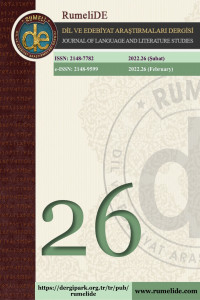Abstract
Son birkaç yılda, özellikle kadınlar için cinsiyetin inşasında değişiklikler olmuştur. Cinsiyet ve toplumsal cinsiyet kavramları, biyolojik olarak insana verilen ile sosyal olarak inşa edilen yönlerine vurgu yapması ile birbirinden ayrılmaktadır. Böylece ideal kadının pasif, sadık ve itaatkâr olarak tasviri de değişmiş oldu. Toplumsal cinsiyet meselesi yeniden şekillenirken, kadın cinsiyetiyle ilişkisi nedeniyle annelik de sorgulanmaya başlamıştır. Bu gereksinimleri karşılayan kadınlar “iyi” anneler olarak etiketlenirken, olmayanlar “kötü" olarak etiketleniyor. Toplumsal cinsiyet ve annelikteki bu değişimler, kadınların günlük yaşamda farklı şekillerde karakterize edilmelerine yol açmış ve bu kadınlar yeni oluşturulan kadın imgelerine özel bir vurgu yapılmak suretiyle edebiyatta tasvir edilmeye başlanmıştır. Dikkatsiz, kötü ve sorumsuz annelerle anneliğin değişen yüzünü gösteren romanlar ve oyunlar da ortaya çıkmıştır. Bununla birlikte, geleneksel bir kadını ve anneyi temsil eden edebi eserler hala mevcuttur. Edebiyatta, geleneksel kadınlık ve anneliğin temsili bile farklılık gösterir, zira bazı yazarlar bu kadınları zayıflıklarını, yaşadıkları baskıyı ve kırılganlıklarını ortaya çıkarmak için kullanırken, diğerleri geleneksel bir kadının ve annenin çocuklarına nasıl güçlü, özverili ve şefkatli olabileceğini gösterme noktasında edebi yeteneklerini kullanırlar. Finlandiya'nın tanınmış edebiyatçılarından Elias Lönnrot, halk hikâyelerinden derleyip kaleme aldığı epik destanı Kalevala ile; Türk edebiyatının en dikkat çekici yazarlarından Yaşar Kemal ise ünlü İnce Memed romanı ile “kadın" ve "anne" kimliklerine karşı tamamen farklı tutumlar ortaya koymaktadır. Bu makalenin amacı Kemal'in İnce Memed'de kadınlığı ve anneliği olumlu bir şekilde tasvir ederken Lönnrot'un ise Kalevala'da küçümseyici bir bakış açısı sergilediğini göstermektir. Birbirinden farklı yazar ve dönemlerden günümüze ulaşan bu iki başyapıtın analizi, Anadolu ve Finlandiya kültürleri açısından farklılıklar göstermektedir.
References
- Arendell, T. (1999). Mothering and motherhood: A decade review. University of California.
- Bockemühl, A. (2009). A woman's path: Motherhood, love, and personal development. Rudolf Steiner Press.
- Butler, J. (1986). Sex and gender in simone de beauvoir's second sex. Yale French Studies. 72, 35-49.
- Choi, P., Henshaw, C., Baker, S., & Tree, J. (2005). Supermum, superwife, supereverything: performing femininity in the transition to motherhood. Journal of Reproductive and Infant Psychology, 23(2), 167-180.
- Dino, G. & Grimbert, J. (1986). The Turkish peasant novel, or the Anatolian theme. World Literature Today, 60(2), 266-275.
- Gay, D. E. (1997). The creation of the Kalevala. Jahrbuch für Volksliedforschung, 42, 63-77.
- Kemal, Y. (2005). Memed, My Hawk. New York Review Books.
- Lönnrot, E. (2008). The Kalevala. Oxford University Press.
- Önal, L. (2011). The discursive suppression of women: Female evils as the villains of the motherhood narrative. Folklore, 48, 85-116.
- Sawin, P. E. (1988). Lönnrot’s brainchildren: The representation of women in Finland’s Kalevala. Journal of Folklore Research, 25(3), 187-217.
- Siikala, A. L. (2004). The many faces of contemporary folklore studies. The Folklore Fellows, 27, 2-23.
Abstract
Over the last few years there have been alterations in the construction of gender, particularly for women. The concepts of sex and gender are divided with sex remaining biological, and gender becoming constructed. The depiction of the ideal woman as passive, faithful, and obedient thus changed. As the gender issue reforms, motherhood has also begun to be questioned due to its association with the female sex. Women who meet these requirements are labelled “good” mothers, while those who do not are “bad”. Such changes in gender and motherhood led to the distinct characterization of women in daily life and these women began to be portrayed in literature with a special emphasis on their newly constructed female images. Novels and plays that display the changing face of motherhood with careless, nasty and irresponsible mothers have also appeared. However, there are still literary works that represent a more traditional woman and mother. In literature, even the representation of traditional womanhood and motherhood differs since some writers use these women to reveal their weakness, oppression, and vulnerability while others use their literary ability to exhibit how a traditional woman and mother can be strong, dedicated and compassionate to her children. Elias Lönnrot, a well-known literary figure in Finland, with his epic compilation of national folklore, The Kalevala, and Yashar Kemal, one of the most noteworthy authors of Turkish literature, with his renowned Memed, My Hawk, unveil entirely divergent attitudes towards the identities of “woman” and “mother”. The aim of this paper is to demonstrate how Kemal portrays womanhood and motherhood positively in Memed, My Hawk, while Lönnrot flaunts a dismissive viewpoint in The Kalevala. Analysis of these two masterpieces from disparate authors and epochs shows their distinctiveness in consideration of the Anatolian and Finnish cultures.
References
- Arendell, T. (1999). Mothering and motherhood: A decade review. University of California.
- Bockemühl, A. (2009). A woman's path: Motherhood, love, and personal development. Rudolf Steiner Press.
- Butler, J. (1986). Sex and gender in simone de beauvoir's second sex. Yale French Studies. 72, 35-49.
- Choi, P., Henshaw, C., Baker, S., & Tree, J. (2005). Supermum, superwife, supereverything: performing femininity in the transition to motherhood. Journal of Reproductive and Infant Psychology, 23(2), 167-180.
- Dino, G. & Grimbert, J. (1986). The Turkish peasant novel, or the Anatolian theme. World Literature Today, 60(2), 266-275.
- Gay, D. E. (1997). The creation of the Kalevala. Jahrbuch für Volksliedforschung, 42, 63-77.
- Kemal, Y. (2005). Memed, My Hawk. New York Review Books.
- Lönnrot, E. (2008). The Kalevala. Oxford University Press.
- Önal, L. (2011). The discursive suppression of women: Female evils as the villains of the motherhood narrative. Folklore, 48, 85-116.
- Sawin, P. E. (1988). Lönnrot’s brainchildren: The representation of women in Finland’s Kalevala. Journal of Folklore Research, 25(3), 187-217.
- Siikala, A. L. (2004). The many faces of contemporary folklore studies. The Folklore Fellows, 27, 2-23.
Details
| Primary Language | English |
|---|---|
| Subjects | Linguistics |
| Journal Section | World languages, cultures and litertures |
| Authors | |
| Publication Date | February 21, 2022 |
| Published in Issue | Year 2022 Issue: 26 |

